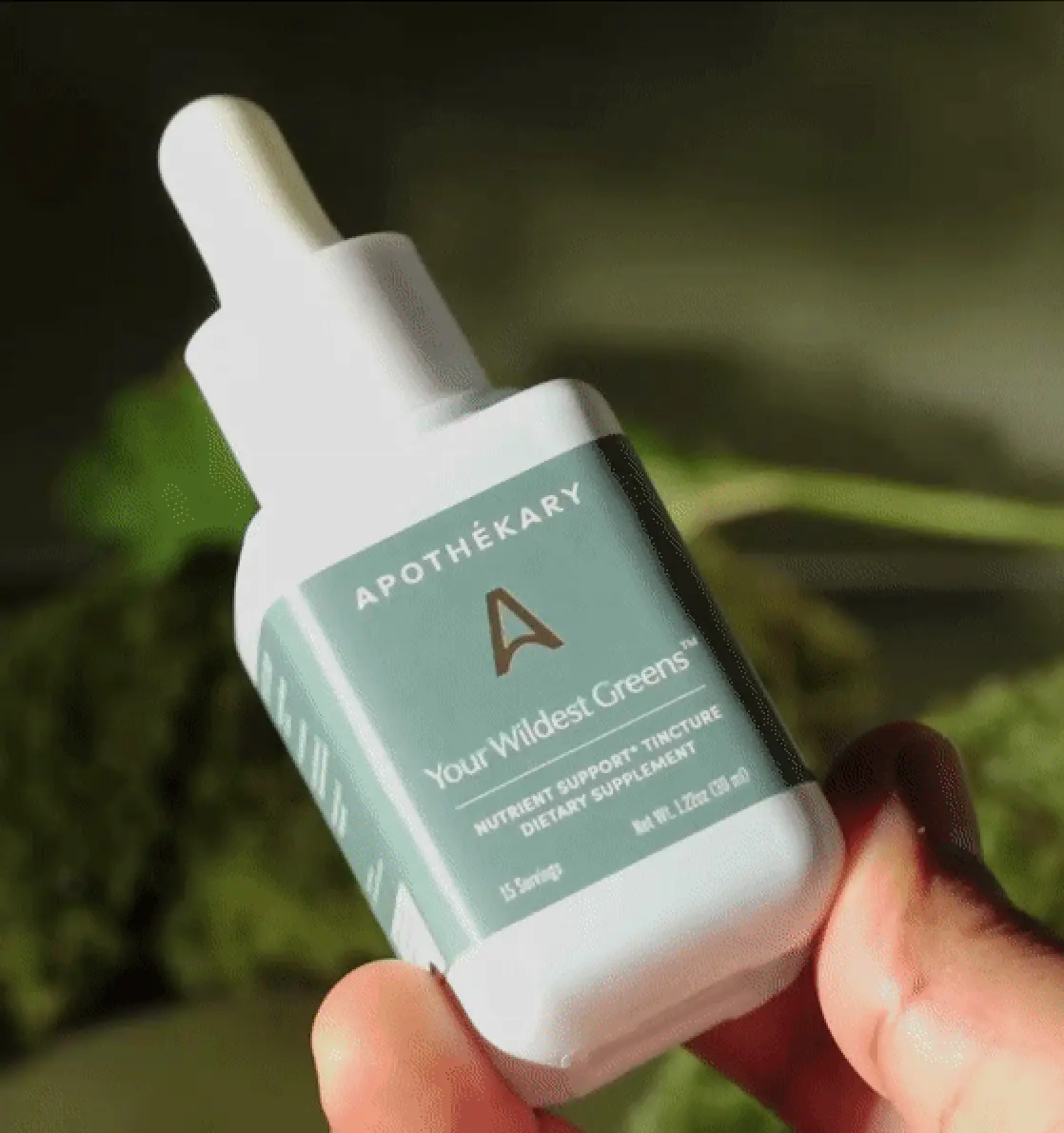Do you struggle with getting your daily greens? Perhaps staying on top of your essential vitamins and minerals on a daily basis is a struggle for you? Well say hello to a first-of-its-kind product—a daily greens support in liquid format. Your Wildest Greens™ features some of the world’s most nutrient-dense plants in easy-to-take drops.
The truth is, it can be a challenge to get the amount of greens, vitamins, and minerals our bodies need for optimal functioning on a daily basis. The body can’t produce minerals and vitamins on its own, so it must be obtained through eating a diverse and nutrient-rich diet. However, most Americans don’t meet their nutrient intake requirements from food alone, and up to 80% don’t consume the recommended amount of vegetables per day either1.
Not only are we not consuming enough plants, but the ones we are eating often lack the nutrient content they previously had—mainly due to industrial agriculture and soil nutrient depletion. Last but not least, stress can further deplete mineral levels in the body. Heightened stress levels can impact both absorption and secretion of nutrients—meaning they aren’t being properly absorbed and are leaving our body too quickly to be utilized2. All of these factors can lead to vitamin and mineral deficiencies.
Why are minerals and vitamins so important for the body?
Vitamins and minerals are key for:
- Metabolic processes (digestion, energy production)
- Nervous system function
- Immune function
- Building and maintaining strong bones, hair, nails, and cartilage
- Hydration
- Regulating hormones
- Skin health
- Stress response
The plants and algae found in Your Wildest Greens™ are known to be great sources of many essential minerals such as iron, iodine, potassium, silica, and calcium as well as an array of vitamins. In addition, we included highly bioavailable isolates of two common nutrient deficiencies—zinc and Vitamin B12. We will explore all the beneficial ingredients below.
Moringa leaf (Moringa oleifera)
Moringa, also known as the “miracle tree” is said to be one of the most nutritious land plants on Earth. The leaves are rich sources of protein, vitamins, calcium, potassium, iron, zinc, magnesium, amino acids, and antioxidants3. Up to 25% of the leaf’s weight is made up of essential amino acids and proteins. The herb contains a considerable amount of vitamin A, as much as 10 times the amount found in your typical carrot per serving.
The vitamin content may also support iron absorption (iron deficiency is very common in women around the world4). Almost all parts of the moringa plant have been used traditionally across tropical climates—from supporting nutrition during pregnancy to helping decrease skin issues with its “anti-aging” properties5. Today, moringa continues to be widely studied for its incredible nutritional benefits for the body. From supporting the body's natural inflammation6 response to supporting collagen production, and heart health7—you can’t go wrong with moringa.
Nettle leaf (Urtica diotica)
Another herb that just seems to do it all is stinging nettle. With a history of use dating back over 2,000 years, nettle leaves continue to be widely used for health benefits worldwide. The protein content alone accounts for almost 30% of the plant’s overall mass and the mineral content accounts for nearly 20% of its dry weight8. Specifically, nettles are known to be abundant in Vitamins K, B2, and A, magnesium, iron, manganese, and a highly absorbable form of calcium.
Nettles are also rich in chlorophyll which contributes to its antioxidant properties and helps aid in alkalizing the body. It is considered to be a tonic herb, with its long-term use benefiting our bodies as a whole. Modern research has shown its particular regulating effects on the cardiovascular, renal, and metabolic systems9. But nettle leaves really seem to do it all—from helping us manage our response to allergens, to supporting the elimination of toxins, while helping keep our bones strong.
Horsetail (Equisetum arvense)
Horsetail is one of the oldest plants in the world with its first record dating back more than 300 million years—it’s truly a living fossil. Horsetail is rich in calcium, iron, potassium, and magnesium and is a nutrient powerhouse for all areas of the body that use silica and collagen.
It can contain up to 25% silica which helps build healthy connective tissues and supports collagen synthesis for bones, hair, skin, and nails10. Higher levels of silica content in the hair can help lower rates of hair loss and increase overall luminosity11. Like the other potent greens in this formula, horsetail has been shown to contain powerful antioxidant properties that help to remove free radicals from the body12.
Dandelion leaf (Taraxacum officinale)
The final wild herb in the Your Wildest Greens™ formula is dandelion. Often ignored as a pesky garden weed, all parts of the plant hold great value for the body. You can find dandelion root featured in many of our Signature Formulas but the leaves of dandelion have their own special benefits.
They are rich sources of vitamins A, B6, C, and K. These vitamins help promote healthy vision, skin, immunity, metabolism, protein synthesis, and more. The bitter leaves also have a particular affinity for the kidneys and their liver-support benefits help to remove excess fluid from the body and work to protect the liver13. When grown under the correct conditions, the herb has also shown potential for supporting healthy blood glucose levels14.
Spirulina (Arthrospira platensis) & Chlorella (Chlorella vulgaris)
Spirulina and chlorella are both blue-green algae and are considered two of the most nutrient-dense superfoods on the planet. Nutrient-wise, they contain essential nutrients often lacking in other plant-based foods. For example, they contain omega-3 and omega-6 fatty acids—rare in many vegan foods. Beyond omegas, both herbs are rich in protein (up to 70% of their mass), vitamins D, B12, and A as well as iodine and iron.
Iodine deficiency is known as a global issue that’s connected to many of the thyroid issues of today15. Spirulina and chlorella are single-celled organisms that lack cellulose cell walls, this fact makes them easy to digest and very bioavailable16. It also makes them sensitive to degradation, so they are treated with care in our extraction process and added at the end to avoid any heat ruining their high nutrient content—if you notice any green sediment in your tincture, know that it’s the algae!
Fun fact: spirulina gained recognition after it was used by NASA to supplement the diets of astronauts on space missions. Supplementing with these superfoods has been shown to help regulate an array of metabolic processes17. They have also shown positive impacts on immune function, energy levels, and natural detoxification. The flavor of these algae can be difficult for some to get behind but taking them with these tasty drops makes it easier than ever.
Zinc (as bisglycinate chelate)
Zinc is an essential trace mineral that over 100 enzymes in the body rely on for proper functioning. Although it's often touted for its benefits for the immune system, its benefits extend across the body. Zinc deficiencies can impact mood, worsen skin conditions, and the proper growth of healthy cells18. A clinical study suggested that zinc supplementation could improve the mood states of young women19.
The form of zinc taken is also an important factor for supplementation. We chose chelated zinc (zinc bisglycinate) for a few reasons. First, since it is bound to an amino acid it is easier for the body to digest (chelated minerals don’t require the same amount of stomach acid to be broken down). Isolates can leave some people with stomach pain. Second, zinc is bound to the amino acid, glycine, which has its own array of benefits for supporting our wellbeing. Lastly, studies have shown that chelated minerals have better absorption rates, up to 43% higher levels of zinc were testable in the blood compared to non-chelated zinc20. Although the study was small in size, the numbers show promise.
Vitamin B12 (as methylcobalamin)
Vitamin B12 is another deficiency common throughout the U.S. and is important to supplement if a proper amount is not obtained from diet alone (especially as we age or if you consume a primarily plant-based diet). It is a key vitamin for the overall function of the nervous system, red blood cell formation, and maintaining healthy energy levels.
Methylcobalamin is known to be one of the most active forms of B12. You may be wondering why Your Wildest Greens™ contains such a high daily value percentage. Our bodies can only absorb a portion of the supplement and anything unnecessary simply gets eliminated from the body. Research has shown our body absorbs as little as 1-2% of B12 so higher doses may be needed to reach recommended daily values21. Higher doses are considered safe and may be necessary for other reasons22.
Peppermint, spearmint, lemon verbena, and lemon peel
Lastly, it would not be an Apothékary tincture without the added functional ingredients that make the formula taste amazing. Peppermint, spearmint, and lemon verbena give the formula a fresh, cooling, and minty sensation and flavor when taken directly in the mouth or in water. They're all beneficial for digestion to further support the absorption and assimilation of all the potent nutrients within. The traditional and well-studied benefits for stress23, mood, and cognition24 don’t hurt either.
Conclusion
Liquid formats of herbs, like tinctures, are generally easier to absorb than powders. While there are many powdered green herbs out there, we felt that the tincture format of Your Wildest Greens™ would give you the most easy-to-absorb, nutrient-rich herbs possible. So, forget the chalky and hard-to-incorporate green powders and try Your Wildest Greens™ instead. Getting your daily greens just got a whole lot easier (and tastier).
https://lpi.oregonstate.edu/mic/micronutrient-inadequacies/overview
https://www.ncbi.nlm.nih.gov/pmc/articles/PMC7442351
https://www.ncbi.nlm.nih.gov/pmc/articles/PMC6379786
https://www.herbalgram.org/resources/herbalegram/volumes/volume-17/number-4-april-2020/food-as-medicine-moringa/food-as-medicine-moringa
https://academic.oup.com/jpp/article/74/3/296/6414694
https://academic.oup.com/jpp/article/74/3/296/6414694
https://www.ncbi.nlm.nih.gov/pmc/articles/PMC8818947
https://www.ncbi.nlm.nih.gov/pmc/articles/PMC9253158
https://www.ncbi.nlm.nih.gov/pmc/articles/PMC9282742
https://www.ncbi.nlm.nih.gov/pmc/articles/PMC2756348
https://www.ncbi.nlm.nih.gov/pmc/articles/PMC4938278
https://pubmed.ncbi.nlm.nih.gov/19067388
https://bnrc.springeropen.com/articles/10.1186/s42269-021-00567-1
. https://pubmed.ncbi.nlm.nih.gov/36080148
https://www.ncbi.nlm.nih.gov/pmc/articles/PMC3074887
https://www.ncbi.nlm.nih.gov/pmc/articles/PMC3136577
https://pubmed.ncbi.nlm.nih.gov/37263369
https://www.hsph.harvard.edu/nutritionsource/zinc
https://pubmed.ncbi.nlm.nih.gov/20087376
https://pubmed.ncbi.nlm.nih.gov/18271278
https://www.ncbi.nlm.nih.gov/pmc/articles/PMC2532799
https://ods.od.nih.gov/factsheets/VitaminB12-Consumer
https://pubmed.ncbi.nlm.nih.gov/35011093
https://www.sciencedirect.com/science/article/pii/S0271531718308431


